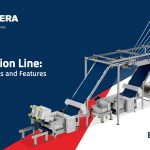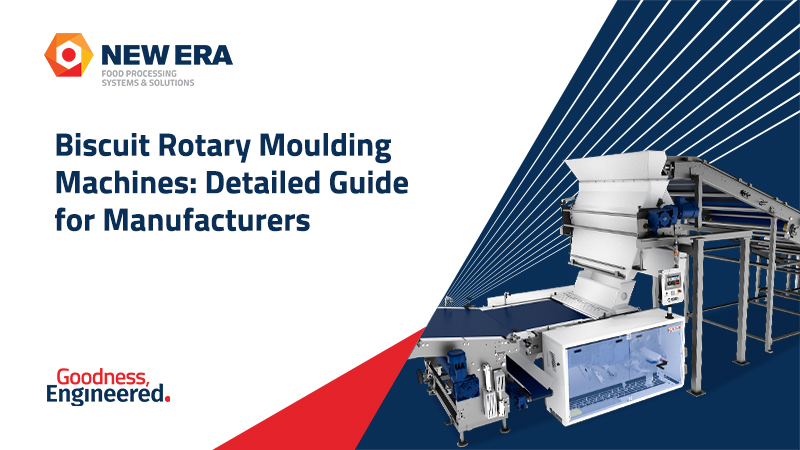The fast-paced manufacturing bakery businesses cannot compromise on consistency and efficiency. This is where Biscuit Rotary Moulding Machines transform the production lines and a combination of craftsmanship and technology. These machines assist manufacturers in producing perfection in each biscuit, consistent in weight, texture, and shape, and have remarkable production speed.
To the contemporary biscuit manufacturers, rotary moulding technology is the way to move forward with regard to maximizing performance, minimizing waste, and producing superior products. Rotary moulding technology is a combination of mechanical accuracy and design flexibility that allows manufacturers to produce attractive-shaped, uniform, and market-ready biscuits with little human involvement.
This blog is a detailed guide for manufacturers about biscuit rotary moulding machines.
What is a Biscuit Rotary Moulding Machine?
A Biscuit Rotary Moulding Machine is mainly used to form biscuits made of soft dough into desired shapes and designs. The machine has the following parts: feed hopper, pressure roller, rotary moulding roller, and extraction belt, each of which is essential in moulding the dough into the required biscuit design.
The unique feature of rotary moulders is that they are capable of making complex shapes and can produce uniformly sized biscuits despite the large scale of production. The patterned holes of the rotary moulding roller predetermine the shape of the final biscuit, and the pressure and extraction systems promote a smooth flow of dough and its soft manipulation.
Compared to the old manual moulding that requires a high level of skills in the operators, rotary moulding automates the process and ensures uniform outcomes in each instance with almost zero human involvement. This comes in handy, especially in large-scale production facilities where precision, cleanliness, and speed are quite important.
How Biscuit Rotary Moulding Machines Work?
The operation of Biscuit Rotary Moulding Machines is a flawless combination of mechanical accuracy and the science of dough movements. The procedure can be broken down into three fundamental steps:
1. Dough Feeding and Compression
A pressure roller is used to compress the dough evenly against the rotary moulding roller, and it is fed into the hopper. The pressure roller maintains a consistent dough density, which eliminates cracks or irregularities in the end product.
2. Rotary Moulding and Design Formation
The dough is then rolled through the engraved rotary moulding roller, which marks the shape, design, and the thickness required in the dough. These rollers are easy to change by manufacturers to make various designs of biscuits, a crucial attribute in brands with varied product lines.
3. Biscuit Extraction and Transfer
After they have been shaped, the biscuits are very subtly lifted off the roller with an extraction web or belt system and put onto the conveyor, where they are baked. The release mechanism is smooth, which ensures that the biscuits maintain their shape as well as detailing during the transfer.
Most major Biscuit Rotary Moulding Machines Manufacturers like New Era have now installed servo-operated rollers, variable speed regulation, and automatic pressure adjustments in their systems to allow precision and flexibility when using a wide variety of different types of dough. These technologies allow it to run smoothly, have minimal wastage, and design it better.
Applications Across Biscuit and Bakery Production Lines
Biscuit Rotary Moulding Machines are mainly brought in to help shape soft dough biscuits, but they may easily be incorporated into other bakery systems to increase the production capacity. They are versatile and therefore come in handy in contemporary manufacturing facilities.
Key Applications:
Soft Dough Biscuits: Perfect with products such as shortbread, butter biscuits, and melt-in-mouth types, where the dough needs very fine shaping.
Combined Production Lines: Most commonly used with rotary cutting lines of hard dough biscuits, which allows a facility to produce both soft and hard dough products effectively.
Integration of Cookie Production: Compatible with wire-cut, deposited, or extruded product lines with cookies, enabling manufacturers to make a wide variety of products, from smooth biscuits to rough, textured cookies.
Diversified Product Portfolios: Allows the flexible production process, which allows manufacturers to produce many different types of products without major discrete changes in set-ups or lengthy downtime.
Streamlined Production Productivity: Facilitates smooth changes between various dough types/recipes and enhances machine usage and productivity of the line.
Flexibility toward Bakery Innovation: Helps manufacturers be quick to adapt to shifting consumer preferences, modifying shapes, textures, and designs with little equipment alteration.
Key Considerations When Choosing a Biscuit Rotary Moulding Machine
To achieve the objectives of production, the appropriate rotary moulding machine should be selected by aligning technical abilities with production objectives. Manufacturers ought to consider:
Capacity of Production: The machine must be able to produce expected volumes per day without overworking or working inefficiently.
Type of Product: Machines are supposed to be in charge of the type of dough (soft, semi-soft, or composite).
Level of Automation: More control and precision are provided by the advanced PLC and servo-based systems.
Maintenance: The easy-cleaning and dismantling of machines that are tool-free saves precious time.
Integration Compatibility: Be compatible with the available mixers, ovens, and conveyors.
Energy Efficiency: Low-power motors and friendly systems are used to cut the operating cost in the long term.
With the selection of the appropriate system, manufacturers have the capacity to strike a balance with performance, cost, and flexibility, and therefore, they can be able to innovate at will in the dynamic bakery market.
The Future of Biscuit Rotary Moulding Machines
With the changing taste of consumers around the world, there is an ongoing demand for biscuits that appear artisanal but are made in batch-like quantities, and this is pushing manufacturers to machines that can merge precision with creative adaptability.
A recent industry report also shows that the global cookie market is growing with a compounded annual growth rate of around 5.7%. In order to be ahead of its time, future Biscuit Rotary Moulding Machines are likely to incorporate the following features:
- Intelligent surveillance and control.
- Predictive diagnostics and maintenance warning.
- Self-learning, adjustment algorithms of different ingredients.
The concept of sustainability will become a priority as well; recyclable materials, energy-efficient motions, and waste designs will be implemented. Essentially, rotary moulding technology is transforming into a shaping instrument to a smart, sustainable center of the next generation of biscuit manufacturing plants.
Conclusion
Biscuit Rotary Moulding Machines are more than a mechanical precision; it is an embodiment of innovation, consistency, and creative freedom in the modern biscuit production. These machines help manufacturers to produce high-quality biscuits that are of global standards and meet the expectations of consumers by being fast and artistic.
With New Era, your ultimate Biscuit Rotary Moulding Machines Manufacturers, we are working on automation, digitalization, and sustainable engineering. Our rotary moulding system is not only a technical choice but a strategy towards excellence, profitability, and future preparedness.
Ready to modernize your biscuit production line?
Advanced Biscuit Rotary Moulding Machine is what you need.
FAQs
1. What is a Biscuit Rotary Moulding Machine?
It is applied to rolling soft dough biscuits with engraved rollers to achieve specific dimensions and textures.
2. What kind of biscuits are possible using rotary moulding machines?
These are mostly applied to soft dough biscuits, though they may also be used in conjunction with lines to cookies and other bakery items.
3. What are the characteristics of a good rotary moulding machine?
Advanced rotary moulding machines have features such as servo-driven controls, PLC systems, hygienic design, and ease of maintenance.
4. Why choose preferred Biscuit Rotary Moulding Machines Manufacturers?
Experienced manufacturers like New Era present quality, adjustable, and energy-saving machines that can be smoothly integrated into various biscuit production systems.


